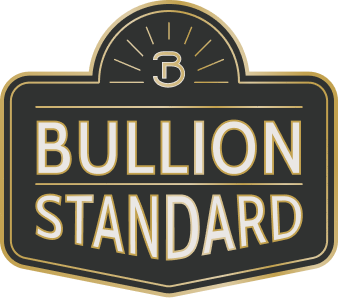The Relationship Between Gold and Inflation
By Bullion Standard ·
5 min read
Ever wondered why gold is the go-to asset for many investors during turbulent economic times? It's not just a coincidence.
Gold has long been considered an inflation hedge. While its price may fluctuate in the short term, gold has consistently proven to be a secure asset, especially as the value of the dollar declines.
This article will explore the gold and inflation relationship — how inflation impacts the price of gold and why gold can be a valuable asset during periods of high inflation. We'll also discuss how global events and monetary policies influence this dynamic, providing you with insights to make informed investment decisions.
What is Inflation?
Inflation is the rate at which the general level of prices for goods and services rises. With rising inflation, the purchasing power of currency decreases.
In other words, your money buys less than it did before.
Central banks often target a specific inflation rate to maintain economic stability, but when inflation spikes unexpectedly, it can erode savings and affect economic activity. These persistent rising prices can be influenced by various factors, including supply chain disruptions, increased demand, and changes in monetary policy.

Why Inflation is a Current Concern
Recently, inflation remains a pressing concern despite recent progress in reducing it from its peak levels.
The U.S. Federal Reserve, often referred to as the Fed, is the central bank of the United States responsible for implementing monetary policy. The Fed aims to stabilize inflation at around 2%, but it continues to hover above this target.
With unemployment still low and economic conditions evolving, the Fed's policy decisions reflect a careful balance to avoid further inflationary pressures.
Historical Context of the Gold and Inflation Relationship
Throughout history, gold has been seen as a store of value. Many cultures have long regarded gold as a reliable medium of exchange and a safeguard against economic instability.
Unlike paper currency, the yellow metal has intrinsic value. During times of high inflation and currency devaluation, gold often retains its value or even appreciates.
Historical events like the hyperinflation of the Weimar Republic or the 1970s oil crisis illustrate how gold acted as a safe haven when traditional currencies faltered.
Why Gold Can Hedge Inflation
Gold bars and coins are well-known for being a hedge against inflation. Their effectiveness stems from several key factors.
For one, gold has an inherently limited supply. As a result, it tends to hold its value when inflation rises. When inflation is high, the value of paper currency declines. However, gold's value typically remains stable or increases.
However, in the short term, gold prices can be volatile and influenced by various factors, including investor sentiment and global events.
Global Events and Their Impact on Gold and Inflation
Global events play a significant role in shaping the dynamics between gold and inflation. Political instability, economic crises, and major geopolitical developments can cause rapid shifts in inflation rates and gold prices.
For instance, during times of war or political turmoil, investors often flock to gold as a safe-haven asset, driving up its price. Similarly, global economic downturns, such as the 2008 financial crisis, tend to result in an increased investment demand for gold as traditional assets lose value.
Additionally, supply chain disruptions, such as those witnessed during the COVID-19 pandemic, can also contribute to inflationary pressures and impact gold prices. Understanding these global interconnections is essential for investors seeking to navigate the complex gold and inflation relationship.

Other Factors that Influence Gold and Inflation
Gold Prices During Inflationary Periods
So, how does inflation affect gold prices? Historically, both digital and physical gold prices have increased during periods of high inflation. For example, during the 1970s, inflation rates were high, and gold prices soared. This trend has been observed in other inflationary periods as well.
Supply and Demand Dynamics
The gold and inflation relationship is also influenced by supply and demand. When inflation rises, investors seek safe assets, increasing the gold demand. As demand rises, so does the price of gold.
How Inflation Expectations Impact Gold Prices
Inflation expectations can also drive gold prices. If investors expect inflation to rise, they may buy gold in anticipation, driving up the price. Conversely, if inflation expectations are low, demand for gold may decrease.
Monetary Policy and Gold Price
Central banks' monetary policies can impact inflation and gold prices. When central banks increase the money supply, it can lead to higher inflation, which often results in higher gold prices.
The Best Way To Use Gold as an Inflation Hedge
Ultimately, while gold can serve as a valuable hedge against inflation, its effectiveness may depend on broader economic conditions and market dynamics. Investors should consider these elements when incorporating gold into their portfolios to mitigate inflation risks.
The best way to help protect against inflation is to include gold in a diversified portfolio. Gold’s stability during inflationary periods can balance the volatility of other investments, reducing overall risk.
Start Investing in Gold Today
Knowing how to evaluate the gold and inflation relationship is essential for making informed investment decisions. Gold’s historical stability and value retention during inflationary periods make it a valuable asset for any investor's portfolio.
Our mission at Bullion Standard is to bring transparency and exceptional service to the bullion industry. Enhance your investment portfolio with reliable assets that safeguard your wealth against inflation. Reach out to our team today and start on your journey towards financial stability and growth.






















